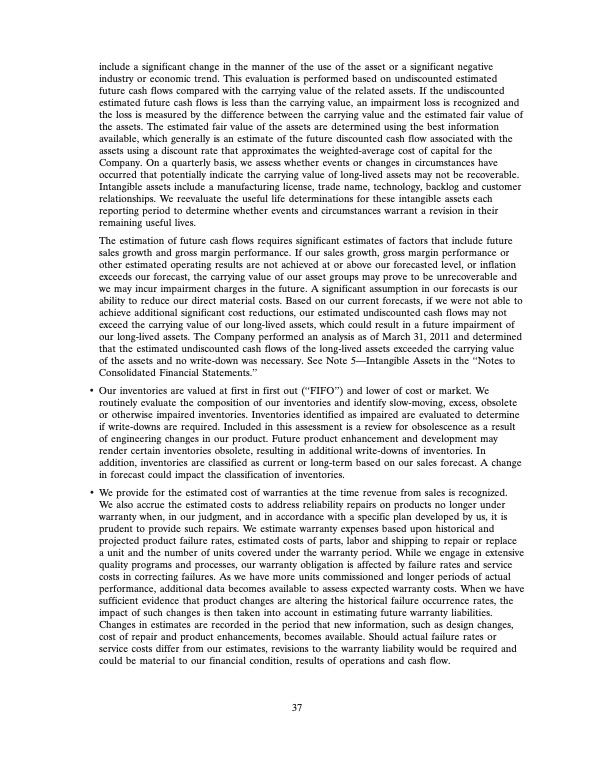
PDF Publication Title:
Text from PDF Page: 057
include a significant change in the manner of the use of the asset or a significant negative industry or economic trend. This evaluation is performed based on undiscounted estimated future cash flows compared with the carrying value of the related assets. If the undiscounted estimated future cash flows is less than the carrying value, an impairment loss is recognized and the loss is measured by the difference between the carrying value and the estimated fair value of the assets. The estimated fair value of the assets are determined using the best information available, which generally is an estimate of the future discounted cash flow associated with the assets using a discount rate that approximates the weighted-average cost of capital for the Company. On a quarterly basis, we assess whether events or changes in circumstances have occurred that potentially indicate the carrying value of long-lived assets may not be recoverable. Intangible assets include a manufacturing license, trade name, technology, backlog and customer relationships. We reevaluate the useful life determinations for these intangible assets each reporting period to determine whether events and circumstances warrant a revision in their remaining useful lives. The estimation of future cash flows requires significant estimates of factors that include future sales growth and gross margin performance. If our sales growth, gross margin performance or other estimated operating results are not achieved at or above our forecasted level, or inflation exceeds our forecast, the carrying value of our asset groups may prove to be unrecoverable and we may incur impairment charges in the future. A significant assumption in our forecasts is our ability to reduce our direct material costs. Based on our current forecasts, if we were not able to achieve additional significant cost reductions, our estimated undiscounted cash flows may not exceed the carrying value of our long-lived assets, which could result in a future impairment of our long-lived assets. The Company performed an analysis as of March 31, 2011 and determined that the estimated undiscounted cash flows of the long-lived assets exceeded the carrying value of the assets and no write-down was necessary. See Note 5—Intangible Assets in the ‘‘Notes to Consolidated Financial Statements.’’ • Our inventories are valued at first in first out (‘‘FIFO’’) and lower of cost or market. We routinely evaluate the composition of our inventories and identify slow-moving, excess, obsolete or otherwise impaired inventories. Inventories identified as impaired are evaluated to determine if write-downs are required. Included in this assessment is a review for obsolescence as a result of engineering changes in our product. Future product enhancement and development may render certain inventories obsolete, resulting in additional write-downs of inventories. In addition, inventories are classified as current or long-term based on our sales forecast. A change in forecast could impact the classification of inventories. • We provide for the estimated cost of warranties at the time revenue from sales is recognized. We also accrue the estimated costs to address reliability repairs on products no longer under warranty when, in our judgment, and in accordance with a specific plan developed by us, it is prudent to provide such repairs. We estimate warranty expenses based upon historical and projected product failure rates, estimated costs of parts, labor and shipping to repair or replace a unit and the number of units covered under the warranty period. While we engage in extensive quality programs and processes, our warranty obligation is affected by failure rates and service costs in correcting failures. As we have more units commissioned and longer periods of actual performance, additional data becomes available to assess expected warranty costs. When we have sufficient evidence that product changes are altering the historical failure occurrence rates, the impact of such changes is then taken into account in estimating future warranty liabilities. Changes in estimates are recorded in the period that new information, such as design changes, cost of repair and product enhancements, becomes available. Should actual failure rates or service costs differ from our estimates, revisions to the warranty liability would be required and could be material to our financial condition, results of operations and cash flow. 37PDF Image | 2011 Annual Report Capstone Turbine Corporation

PDF Search Title:
2011 Annual Report Capstone Turbine CorporationOriginal File Name Searched:
Capstone-AR2011.pdfDIY PDF Search: Google It | Yahoo | Bing
Capstone Turbine and Microturbine: Capstone microturbines used and new surplus for sale listing More Info
Consulting and Strategy Services: Need help with Capstone Turbine, sizing systems, applications, or renewable energy strategy, we are here to assist More Info
Container Lumber Dry Kiln: Since 1991 developing and innovating dry kilns using standard shipping containers More Info
Supercritical CO2 Lumber Dry Kiln: Compact fast drying in 3 days or less for small amounts of wood and lumber drying More Info
BitCoin Mining: Bitcoin Mining and Cryptocurrency... More Info
Publications: Capstone Turbine publications for microturbine and distributed energy More Info
FileMaker Software for Renewable Energy Developing database software for the renewable energy industry More Info
CO2 Gas to Liquids On-Demand Production Cart Developing a supercritical CO2 to alcohol on-demand production system (via Nafion reverse fuel cell) More Info
Stranded Gas for low cost power Bitcoin Mining Using stranded gas for generators may provide breakthrough low power costs for cryptocurrency miners. More Info
| CONTACT TEL: 608-238-6001 Email: greg@globalmicroturbine.com | RSS | AMP |